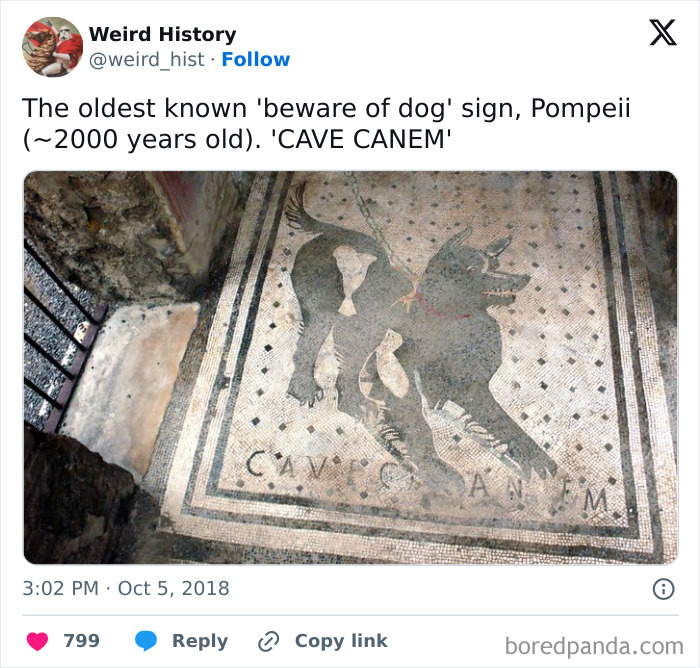
50 ‘Weird History’ Pics That May Rewrite The Narrative Of How You Think The Past Went (Best Of All Time)
Historians will tell you that it's important to study the past because it helps us understand why things are the way they are in the present. And, as we know, the world can be a very strange place at the best of times. The halls of history are decked with all sorts of weird and wacky moments. Some might make you cry with laughter, while others could leave your jaw on the floor. There are historical accounts that make us wonder, "What were they thinking?" And there are those we wish had never happened.
To better understand how things got so wild, we turned to an X account called Weird History. Located "somewhere between space and time," it shares interesting, odd, and funny things that have happened throughout history. It's amassed more than 176,000 followers, getting their daily dose of our "never a dull moment" past. Keep scrolling for Bored Panda's best-of-all-time posts from the page. And don't forget to upvote your favorites.
This post may include affiliate links.
A quick google search reveals that there’s no shortage of “Bizarre Historical Events” that have taken place throughout the days that came before us. Go ahead, and try it yourself. But be warned: you might end up down a long rabbit hole with many crazy twists and turns.
One of the search results that caught our eye involved people dancing themselves to death. Better known as The Dancing Plague of 1518, it was an actual "event" that happened in once upon a time in France. And it was anything but fun.
Rosalind Jana described it best, when they wrote the following for the BBC: “On a sweltering summer's day in July 1518 a woman called Frau Troffea steps into a square in Strasbourg and begins to dance. At first those around her only watch, curiosity piqued by this unusual public display. They watch a woman who will not, cannot, stop."
"She dances for nearly a week, felled occasionally by exhaustion but largely undaunted by the body's other warning signs: pain, hunger, shame. There is no music. Her heart keeps the tempo, working hard to make the motion continue,” added Jana.
Within a week, more than 30 people had joined the ”silent disco.” And by the end of the month, there was a crowd of around 400. Some died. Some survived. But the incident left "experts" puzzled. Back then, there were several theories around what could have caused the dancing plague. They ranged from demonic possession to overheated blood.
But some modern historians say the probable cause was something called ergotism, meaning the dancers had possibly ingested ergot, a psychotropic mold that grows on stalks of rye. "Ergotism is known to trigger delusions and spasms, but results to hardships in coordinated movements therefore disqualifying it as a substantial cause for the phenomenon," notes the World Atlas.
According to Britannica, the most widely accepted theory comes from a medical historian called John Waller. He believed the dancing plague was a form of mass mental disorder, known as a psychogenic or conversion disorder. "Such outbreaks take place under circumstances of extreme stress and generally take form based on local fears," reads the Britannica site.
When presenting his evidence, Waller cited a series of stressors that were affecting residents at the time of dancing plague of 1518. Famines, smallpox and syphilis being the main reasons that hundreds might have felt overwhelmed with life.
Yes it is. Have seen something similar at the Mount St Helens Visitor Center. Worth a visit.
There was another Google search result that caught our attention during the hunt for strange historical events… Nowadays, it’s pretty much accepted that you’d have to be alive to be able to appear in court, and defend yourself against any allegations. But apparently that wasn’t a requirement in 897, when the Vatican put on a display that could have drawn millions of viewers had live court reality shows been a thing back then.
Pope Formosus had been dead for a few months. But one Pope, Stephen VI, was not going to let him rest without paying for his sins. In what's now known as the Cadaver Synod—or Cadaver Trial—Formosus' corpse was summoned to court to, quite literally, sit in on his own trial.
His body was removed from its tomb, dressed in its ecclesiastical robes, and propped up on the papal throne to stand trial. Knowing that the dead man couldn't speak, Pope Stephen VI appointed a deacon to speak on the corpse’s behalf. Pope Formosus might have appointed a different spokesperson if he'd had a choice. The dead pope ended up being found guilty of "usurping the papacy." But we will probably never know how he felt about the verdict.
In case you're wondering why the streets are empty, they're not. Early photography required insane exposure times of 20m or more in broad daylight, so they would only capture things which weren't moving, like buildings.
Note: this post originally had 90 images. It’s been shortened to the top 50 images based on user votes.
Very cool post. But why call it 'best of all time'? After a few dozen times that phrase loses it's meaning...
It should read Best of All Time Until the Next Time
Load More Replies...Very cool post. But why call it 'best of all time'? After a few dozen times that phrase loses it's meaning...
It should read Best of All Time Until the Next Time
Load More Replies...
 Dark Mode
Dark Mode  No fees, cancel anytime
No fees, cancel anytime 








































































